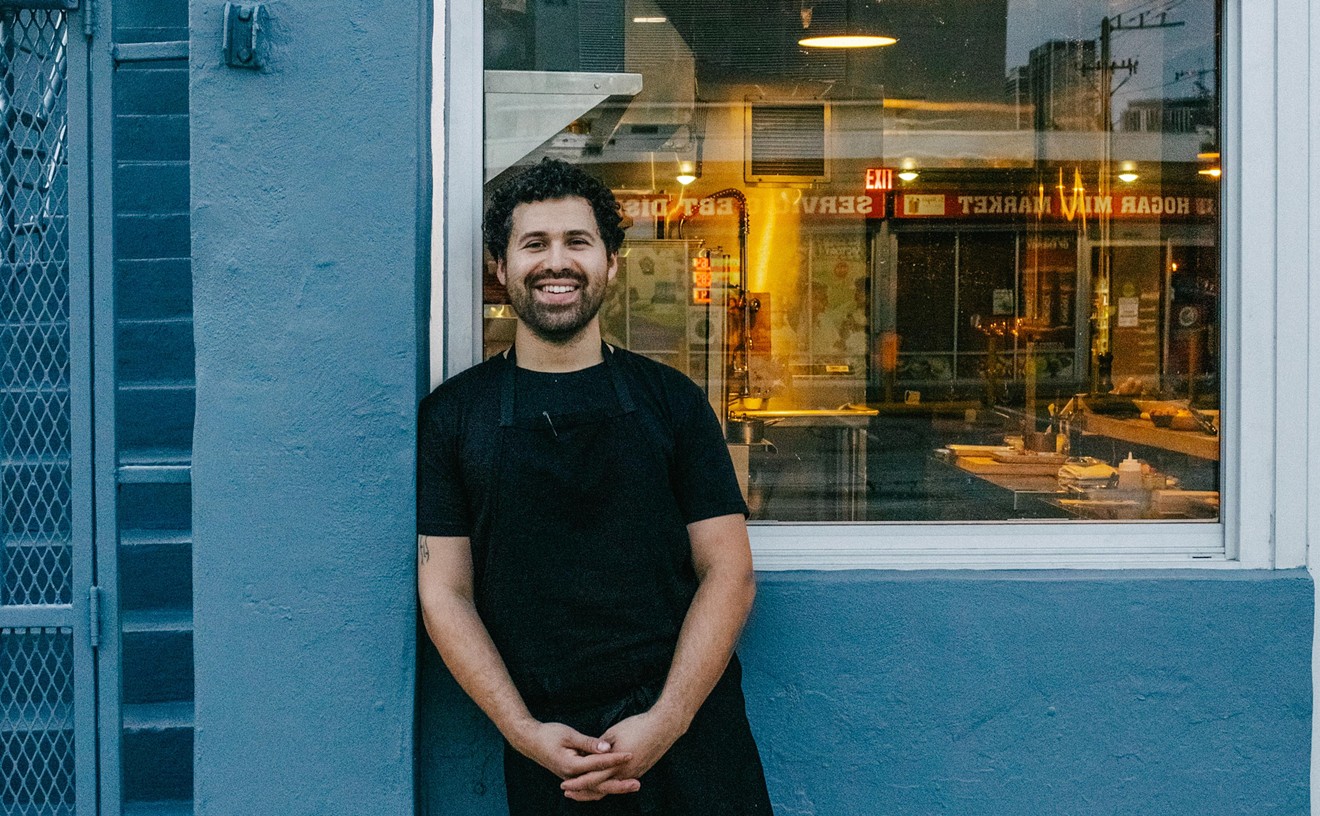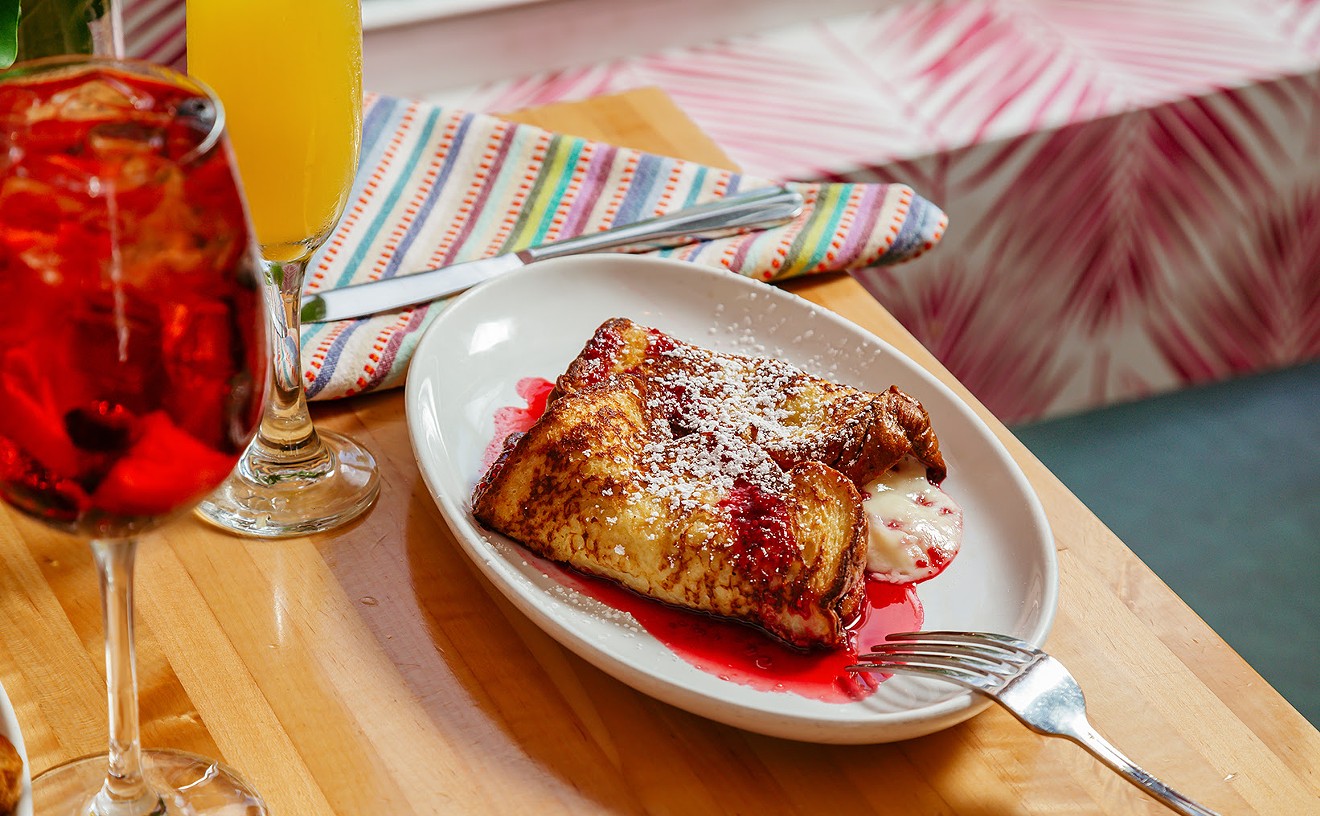Roadside Barbecue opened a year ago in downtown Miami. Owners Hans Seitz (from
Queens, New York), and Kevin Kehoe (from Woodbury, Long Island), had originally
talked of doing a barbecue truck, "but
Miami specifically says, in its code, 'no barbecue trucks,'" explains Hans, AKA
Sparky. "So I wasn't going to spend a whole lot of money only to find out I
couldn't do that." Kevin (also known as Sparky), in Minnesota at the time,
recalls that he, too, had similar plans. "I had a barbecue trailer, and
Hans was going to do the same thing here. He ran into a bunch of laws, so he
said 'What about doing a restaurant?'"
Do
it they did, and Sparky's has been packing its 48 seats on NE Second Avenue and First Street ever since. The
storefront restaurant exudes a down-home, roadside coffee-shop ambiance, with
wooden tables painted in pastel green and a roll of paper towels upon each one
(as of now there is no air-conditioning, but plenty of whirling fans). The
walls are posted with blackboards, beer signage, and a collection of
distinctively painted birdhouses showcasing characters such as the grim reaper,
the Mario Bros, and the Three Little Pigs. I sat down with the two barbecue
mavens and asked them all about all sorts of things, starting with those
birdhouses.
Hans Seitz: Part of my backyard was decorated with them, so I'm bringing a bit of my home
here. My wife Mimi, the kids, and our friends all chipped in and painted
the bird houses.
Kevin Kehoe: The one made to look like an outhouse is mine.
New Times: When did you guys first get together?
KK: It was like a million years ago [the '80s]. We were working at Who's In The
Grove.
HS: That's where we met Michael Moran [currently chef/instructor of FIU and
Culinary Coordinator for SBWFF].
KK: Mike was the executive chef of the restaurant, which was owned by Stewart
Copeland of The Police, Herbie Hancock, and Maria Conchita Alonso.
And that's when you started calling each other Sparky?
KK: We were all Sparky there. There was this guy Brian from New York, and he was also Sparky.
HS: No, he's not Sparky. He's Lyin' Brian.
KK: [laughs] That's true, he is Lyin' Brian.
Where did the barbecue idea come from?
HS: Kevin got to work with Steven Raichlen.
KK: It was his birthday party, and a friend of mine [Moran] called me and said, "Hey, can you help this guy out?" I said, "Sure." My brother John and I went over to [Raichlen's] house and he had like ten smokers in his back yard. He was cooking basically everything for his current book at that time.
HS: After that, Kevin gave me a book on barbecue, and I really got into it."
KK: That's when Hans and I started messing around with rubs and everything. Hans modified this grill into a smoker. We experimented together and came up with our own techniques for direct grilling, indirect grilling, different rubs...
What kind of smoker do you use now?
HS: Now we use an electric convection smoker.
KK: It's a machine the size of a hummer in the middle of our kitchen. [Both laugh.] Because it's a convection smoker it takes less time to cook things. So the average cooking time for a twelve-pound brisket would be like an hour and ten minutes per pound, but we need only half that time. We can cook a twelve to fifteen-pound brisket in six hours as opposed to 12 or 13 or 14 hours.
HS: The golden mark is 175F to 180F internal degrees.
KK: That's the sweet spot for a brisket.
And the wood?
KK: We use a mixture of hickory and apple. The hickory gives it a dense smokiness, and the applewood kind of throws a little sweetness in there. I think it's a nice blend.
HS: We get the wood shipped to us from Maine.
KK: There's a farm up there and that's all they do -- grow trees and throw them into the chipper to die for our cause.
How do you describe your barbecue?
KK: Our barbecue is not specific to any region. It's our version of all regions of barbecue. People from Texas come in and say, "Oh my God, this is really good" -- and Texas is known for its brisket. We had a couple last night -- the woman was from Texas and the guy was from Mississippi. He came in and said, "I'm the barbecue king!," and I said, "OK, but I am too." He was like, "I don't know, you're a little light-skinned to be cooking barbecue." I said, "Well, my partner's a little darker than I am." [Laughs] They each got combos, big piles of food, and not a word passed between them the whole time they were sitting there. They were just chowing down, and he kept looking up at me and winking, you know. It was great.
It happens all the time -- "You're from New York, how do you cook barbecue?" I say, "Well, sit down, and have a try." People are always happy, the plates are always clean.
Tomorrow: Part two, when we talk about pickling hot peppers for barbecue sauce, a woman who sells tutus and cupcakes, and why they carry American microbrews.
Follow Short Order on Facebook and Twitter @Short_Order.










